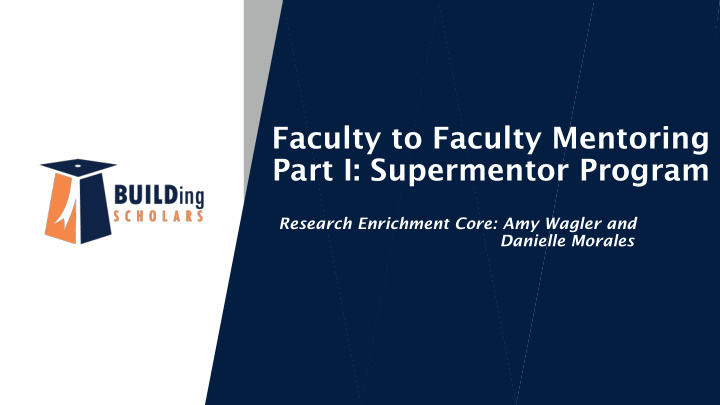



Faculty to Faculty Mentoring Part I: Supermentor Program Research Enrichment Core: Amy Wagler and Danielle Morales
Disclaimer This e-Conference, meeting materials and related content are solely the responsibility of UTEP and do not necessarily represent the official views of the National Institutes of Health.
Outline • Supermentor Description • Hallmarks Addressed • Evaluation of Hallmarks • Program Results
Supermentor Program Description • Who: Faculty at UTEP and Pipeline Institutions • What: The Supermentor Program provided an opportunity for junior faculty from UTEP and Pipeline institutions to be mentored by experienced and successful faculty, primarily from Research Partner institutions. • Hallmarks: FAC-7, FAC-8, FAC-9, FAC-10, FAC-12
Supermentor Program Faculty Mentee Supermentor UTEP Research Partner Research Partner Pipeline Partner Pipeline Partner UTEP
Supermentor Details Benefits: • For Faculty Mentee: Mentoring by an accomplished researcher to develop • Competitive grant proposals • New skills or research manuscripts • For Supermentor: • Connect with potential collaborator at MSIs • $1,500 honorarium Commitment: • Supermentor • Up to five hours/month for 11 months • Respond to and provide comments on written work within 2 weeks of request
Supermentor Details • 3 cohorts (2016-17, 2017-18, 2018-19) • 16 total mentor/mentee pairs • Almost all pairs focused on writing a specific grant proposal or strengthening skills related to developing a strong grant proposals • Many pairs resulted in ongoing research collaborations and funding
Supermentor Program Hallmarks
Hallmark Evaluation • Hallmarks are found at: https://www.nigms.nih.gov/training/dpc/Pages/success. aspx • All hallmarks focus on • faculty research productivity • securing of external funding • building professional networks • Evaluation was a mix of qualitative and survey data • Both the mentees and the mentors were surveyed • Progress reports were required every three months
Hallmark Evaluation - Progress Reports During the Supermentor program, mentees are asked to return feedback on the following: 1) Please comprehensively describe your activities over the last ten months. Include mention of 1) email exchanges, 2) phone conversations, 3) implementation of the Feed Forward model for a grant proposal idea, 4) other assistance with grant proposals, 5) journal articles reviewed, 6) or other activities in which you have engaged. 2) Discuss any problems that you have encountered. 3) Please describe your plans for the next ten months in terms of the Supermentor program. Evaluation team used responses in evaluation reports
Hallmark Evaluation-Final Surveys • Surveys were administered to mentors and mentees at the end of the Supermentor program Topics Questions Satisfaction Self-reported level of satisfaction with mentor/mentee experience • Have you encountered any issues? • Do you have any suggestions for improvements? • Research Productivity Any manuscripts submitted or published? Funding Any proposals submitted or awarded?
Hallmark Evaluation-Research Products Evaluation team recorded numbers of publications , presentations , grant proposals and awards • Sent personalized emails to mentee and mentor pairs two times per year for • Updates on research manuscripts and • Updates on grant proposals • Required ORCHID ID for all research manuscripts and RFA identifier for all grant proposals • Compliance was difficult for faculty not accustomed to these requirements
Supermentor Results Increased number of faculty involved in mentoring or training programs and collaborations. • Consistently high levels of satisfaction reported: • Mentor (n=17) 12% 12% 29% 47% Products: • Mentee (n=14) 7% 7% 14% 36% 36% Collaborations produced $1,937,972 • 0% 20% 40% 60% 80% 100% in external research funding Very Dissatisfied Dissatisfied Neutral Satisfied Very Satisfied Six research publications as of Spring 2019 • Negatives: • Many reported that the program lacked structure and lack of interest, guidance and communication from mentors • Suggestions/changes: • Summer Sabbatical Conference event • Based on feedback, we are integrating the Supermentor program into a more formal grant writing mentoring program • in Phase II
Questions? - Thank you!
Recommend
More recommend